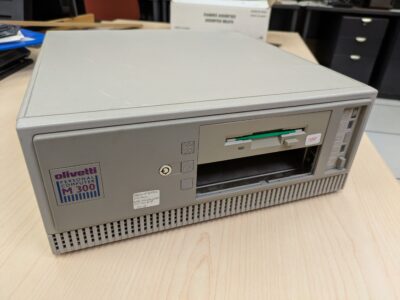Olivetti M300
[vin36]
The Olivetti M300 was a line of Italian-designed desktop computers introduced in the early 1990s, notable for their modular architecture and support for a range of Intel processors, including the 386SX and later 486DX2 CPUs. Its claim to fame lies in its flexible upgrade options—early models could be upgraded by swapping processor cards, and the series featured advanced (for the time) integrated VGA graphics, PS/2 ports, and support for up to 36MB of RAM, making it a robust and business-oriented PC that reflected Olivetti’s reputation for combining elegant design with solid engineering. While the M300 was not a major bestseller in North America and saw limited popularity compared to contemporaries from IBM or Compaq, it was used in Canadian offices and institutions, particularly in Quebec, as evidenced by vintage computer collectors and users in the region.
- Manufacturer: Olivetti, an Italian company renowned for its innovative computer and electronics products
- Type: Desktop computer
- Release Date: 1988
- Cost at release: USD $2,000 (CAD ~$5,500 adjusted for inflation)
- MIPS: 5
Hardware Specifications
- CPU: Intel 80386SX, typically 16 or 20 MHz (later models could use 486DX2 CPUs)
- Memory: Standard 1 MB, expandable up to 36 MB
- Storage: 3.5-inch floppy disk drive (1.44 MB); hard disk options (usually 40 MB or higher)
- Graphics: Integrated VGA graphics
- Ports: PS/2 keyboard and mouse ports, serial and parallel ports
- Expansion: Multiple ISA slots for additional cards
- Modular architecture: Processor card could be upgraded
- Power supply: Standard AT form factor
- Display: Supported VGA monitors
Operating System & Programming Languages
- Operating System:
- The Olivetti M300 primarily ran MS-DOS (versions 3.3, 4.01, and 5.0), IBM PC DOS, and was also compatible with OS/2 (up to Release 2.0) and UNIX (386 version).
- It could run early versions of Microsoft Windows (Windows 2.0 and Windows 3.x), and later models could even support Windows 95
- Supported Languages:
- BASIC (GW-BASIC, QBasic, QuickBASIC), Pascal (Turbo Pascal), C and C++ (Microsoft C, Borland C++), FORTRAN, Assembly language (using MASM, TASM), COBOL, dBASE and other database languages
- Because it was IBM PC-compatible, virtually any language or development environment designed for DOS or early Windows could be used on the M300
Notables
- The Olivetti M300 featured a modular architecture, allowing users to upgrade the CPU by swapping processor boards—an unusual and advanced feature for its era.
- It was among the first European PCs to adopt the Intel 80386SX processor, offering true multitasking and improved speeds over its 80286-based predecessors.
- The case design included front-panel indicators, a volume control for the internal speaker, a reset button, and a security lock, reflecting Olivetti’s focus on both usability and security.
- The M300 could be upgraded from the earlier M290 model simply by replacing the processor board, making it cost-effective and adaptable for businesses.
- Olivetti’s emphasis on design aesthetics and modularity set the M300 apart from more utilitarian American PCs, reinforcing Olivetti’s reputation as a sophisticated European alternative during a period dominated by IBM and Compaq.
- While the M300 did not have a widely recognized nickname, its modularity and upgradability made it notable among collectors and vintage computing enthusiasts.
- Some rare or custom versions of the M300 have been spotted, with unique case designs or hardware modifications, adding to its mystique in the vintage computing community.
- The M300’s place in computing history is as an influential, forward-thinking system that blended advanced hardware with user-friendly design, helping extend the lifespan of business PCs and showcasing European innovation in the late 1980s
Donated by: Arlen Michaels